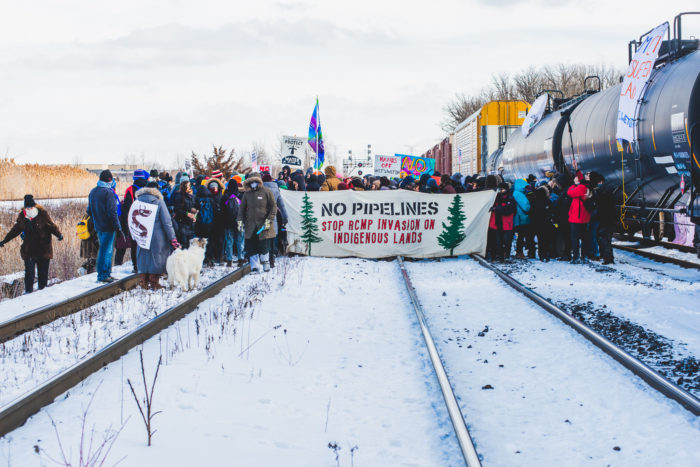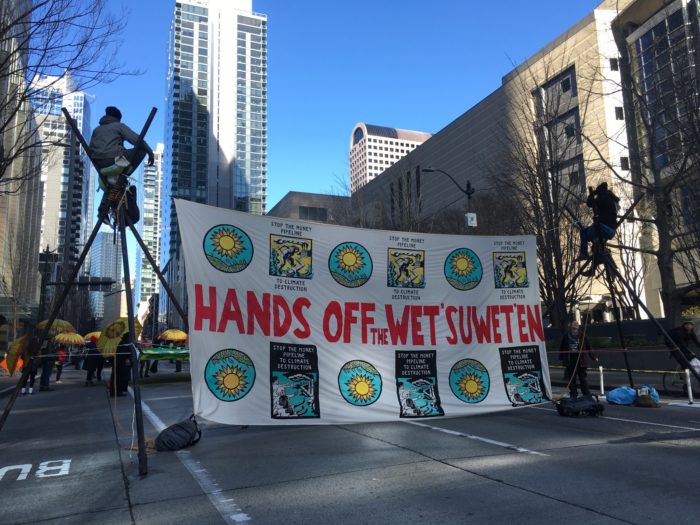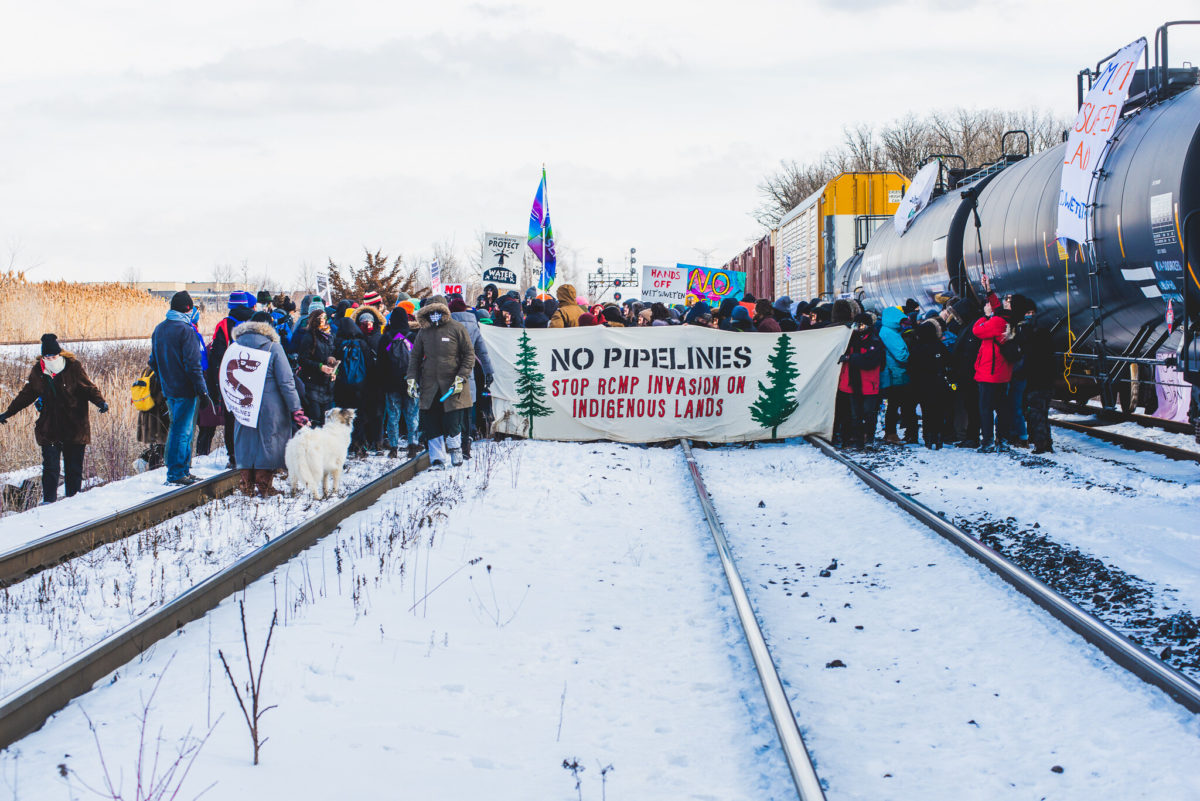The short version
In 2020, 27 banks from around the world took part in a CAD $6.8 billion (USD $4.8 billion) project finance loan to fund the construction of the destructive, rights-violating Coastal GasLink pipeline. Around the same time, a deal closed between TC Energy and two new investors in the project: KKR and AIMCo. We don’t know exactly who’s insuring the project — but we have a pretty good guess. The pipeline is slated to carry fracked gas to LNG Canada, a massive liquefied natural gas project backed by five major oil and gas companies. Keep reading for all the details.
Coastal GasLink resistance
For the past twelve years, the Wet’suwet’en have asserted their sovereignty to stop fossil fuel companies from trespassing on their lands. The Wet’suwet’en legal system predates Canada’s, and the community won in the first Aboriginal title case in Canadian history in 1997, defining Aboriginal title in a case to stop clear-cut logging. These rights have never been extinguished. Under ‘Anuc niwh’it’en (Wet’suwet’en law), the five clans of the Wet’suwet’en have not provided the free, prior, and informed consent to Coastal Gaslink and its parent company TC Energy to do work on Wet’suwet’en territory.
And yet, the Canadian government and British Columbian governments are ramming through the 670-kilometer (420 mile) Coastal GasLink pipeline, which would carry fracked gas from northeast British Columbia to the largest liquefied natural gas (LNG) project in Canadian history: LNG Canada.
In September 2021, Coastal GasLink bulldozed an ancient Wet’suwet’en village site, despite consistent calls to action and legal requirements to respect the site from Wet’suwet’en hereditary chiefs and archeologists alike. Right now, TC Energy’s contractors building the pipeline are attempting to drill underneath sacred waterways.
As Sleydo’, spokesperson for Gidimt’en Checkpoint, shared in a September 30 press release:
“They are trying to drill under the Wedzin Kwa river, the sacred headwaters that feeds all of Wet’suwet’en territory and gives life to our nation. Days ago, CGL [Coastal GasLink] destroyed our ancient village and cultural heritage site, Ts’elkay Kwe. We refuse to allow this destruction to continue and are now blockading CGL. Our Chiefs – not CGL or Canada – have full jurisdiction on our yintah.”
Back in January 2020, the Canadian government spent nearly 20 million dollars on a violent military raid, in which the Royal Canadian Mounted Police deployed snipers, helicopters, and police dogs to remove Wet’suwet’en hereditary chiefs, community members, and supporters from their land while they were in prayer. In response, thousands of people filled the streets across North America and around the world, demanding respect for Wet’suwet’en leadership and sovereignty. Solidarity organizing resulted in weeks of rail blockades and port shutdowns, and youth from more than 30 Indigenous nations occupied the steps of British Columbia’s parliament building for 11 straight days.
Resistance to the project is hitting a boiling point once more, as leaders from Gidimt’en call on the community to defend against the trespass and destruction on their land. In October 2021, hereditary chiefs from the Likhts’amisyu Clan seized Coastal GasLink’s equipment, asserting their law and protecting their territory.
The banks, insurance companies, and investors that are still supporting the Coastal GasLink pipeline are contributing to this clear abuse of Indigenous rights, even though many of them have stated policies acknowledging the right to free, prior, and informed consent of Indigenous communities.

Who’s financing the pipeline? October 2021 Update
RAN published the original “Who’s banking the Coastal GasLink pipeline?” blog in January 2019. Here’s where things stand now.
Banks:
On May 25 2020, TC Energy announced that Coastal GasLink had secured a project finance package that would cover up to 80% of the pipeline’s construction costs. The loan was signed in April and re-upped in October to a total of CAD $6.8 billion. It was extended by a group of 27 banks, with Royal Bank of Canada leading the deal.
Here’s the full list of banks backing Coastal GasLink, organized by country:
- Australia: National Australia Bank
- Canada: ATB Financial, Bank of Montreal, Bank of Nova Scotia, Canadian Western Bank, CIBC, Export Development Canada, National Bank of Canada, Royal Bank of Canada, TD
- China: Bank of China, China Construction Bank, ICBC
- Germany: KfW IPEX-Bank, Landesbank Baden-Württemberg
- Japan: Mizuho, MUFG, SMFG, Sumitomo Mitsui Trust Bank
- Singapore: United Overseas Bank
- South Korea: Kookmin Bank
- Spain: CaixaBank
- US: Bank of America, Citi, JPMorgan Chase, Raymond James, Truist Securities (formerly SunTrust Robinson Humphrey)
In the run-up to the deal, more than 230,000 of you signed a petition demanding that JPMorgan Chase stay far away from Coastal GasLink and cut ties with TC Energy. Thousands of people contacted Chase executives and took to the streets to shut down its branches from Seattle to Ithaca. And yet, Chase chose to directly finance the destructive pipeline. It’s no surprise, as Chase is the largest banker of fossil fuels in the world, but it does mean that we have to ramp up the pressure to stop business as usual.

Investors:
Before the banks unlocked their financing, TC Energy had to complete a sale of partial ownership of the pipeline to new global investors.
On May 25, 2020, TC Energy closed a deal selling 65% of the project to investment firm Kohlberg Kravis Roberts & Co (KKR) and Alberta Investment Management Corporation (AIMCo). Big banks HSBC, TD, and Royal Bank of Canada helped make this ownership sale happen.
Despite new owners, TC Energy is continuing to manage all construction and operation contracts, on behalf of this new partnership:
- TC Energy (formerly TransCanada), is a major North American fossil fuel infrastructure company — and promoter of the now-dead Keystone XL pipeline.
- KKR is a publicly-traded American global investment firm headquartered in NYC, with USD $429 billion in assets under management as of June 2021. This purchase was made in partnership with South Korea’s state-run pension fund, the National Pension Service of Korea (NPS).
- AIMCo manages USD $118 billion in assets on behalf of 32 Alberta pension, endowment, and government funds. It is a Crown corporation, which in this case means that it is owned by the government of Alberta.
KKR and AIMCo have come under increasing scrutiny for betting individuals’ retirement savings on such a risky, rights-violating project. From London to Alberta, people are mobilizing and demanding that these investors drop the pipeline.
Insurance:
Unfortunately, we don’t know exactly which insurance companies are providing the insurance necessary for Coastal GasLink’s construction and operation. In fact, in light of increasing attention on insurance companies providing coverage for destructive fossil fuel projects, in May 2021 TC Energy petitioned the Canada Energy Regulator to let it keep its insurers secret — a petition that was granted in September 2021.
However we do know the companies insuring TC Energy’s five major gas pipelines that are regulated by the Canada Energy Regulator, through June 2021: for every single one of these pipelines, Liberty Mutual provided the bulk of the insurance, with AEGIS and Energy Insurance Mutual providing additional coverage. It is highly likely that these are the companies who will insure the Coastal GasLink pipeline as well — at least unless they care to prove otherwise.
Liberty Mutual is already a top target for the movement calling on the insurance industry to stop fueling the climate crisis and respect human rights. The Boston-based insurance giant is one of the biggest oil and gas insurers globally and has been linked to the Trans Mountain tar sands pipeline and other fossil fuel expansion projects in North America, Asia, and Australia.
Who’s behind LNG Canada?
Coastal GasLink is slated to carry fracked gas across the province to LNG Canada, a proposed liquefied natural gas (LNG) facility on the coast in Kitimat, British Columbia. The $40 billion project represents the largest private-sector investment in Canadian history, and if operational, the first phase of LNG Canada would export up to 14 million metric tons a year of fracked gas in liquid form to Asia.
Back in October 2018, LNG Canada made a final investment decision to move forward with the first phase of the project, and formed a joint venture with five major oil and gas companies in Europe and Asia. LNG Canada’s ongoing construction is being funded by these five companies:
- Royal Dutch Shell, the oil and gas giant based in the Netherlands, owns 40% of the project.
- The Malaysian state oil and gas company PETRONAS has a 25% share.
- Petrochina Company Limited – a Chinese state-owned company and Asia’s largest oil and gas producer – has a 15% stake.
- Japan’s Mitsubishi Corporation, a massive conglomerate that spans ten business areas including oil and gas, also has a 15% stake.
- The Korea Gas Corporation (KOGAS), one of the largest LNG-importing companies in the world, owns the last 5%.
What’s next
Coastal GasLink is facing delays and likely significant cost overruns. In fact, this financial risk has caused a public dispute between TC Energy and LNG Canada.
From the boardrooms to the frontlines, this fight is not over. Wet’suwet’en resistance to the project remains strong, and the role of the Canadian government, banks, insurers, and investors in supporting Coastal GasLink, TC Energy, and LNG Canada is being exposed.
Today, Wet’suwet’en leaders sent a letter to the investors and banks supporting Coastal GasLink and the companies behind LNG Canada, urging them to cease investing in and financing these destructive projects. The world is watching, and Wet’suwet’en land defenders, RAN, and allies will keep the pressure on these banks and investors to stop supporting Indigenous rights abuses.
How to support
Donate: We encourage everyone to support Wet’suwet’en resistance by donating to Gidimt’en Yintah Access point.
Add your name: Sign this petition to demand that Chase and KKR immediately cut ties with Coastal GasLink.
Banking information sourced from Bloomberg Finance, L.P.
